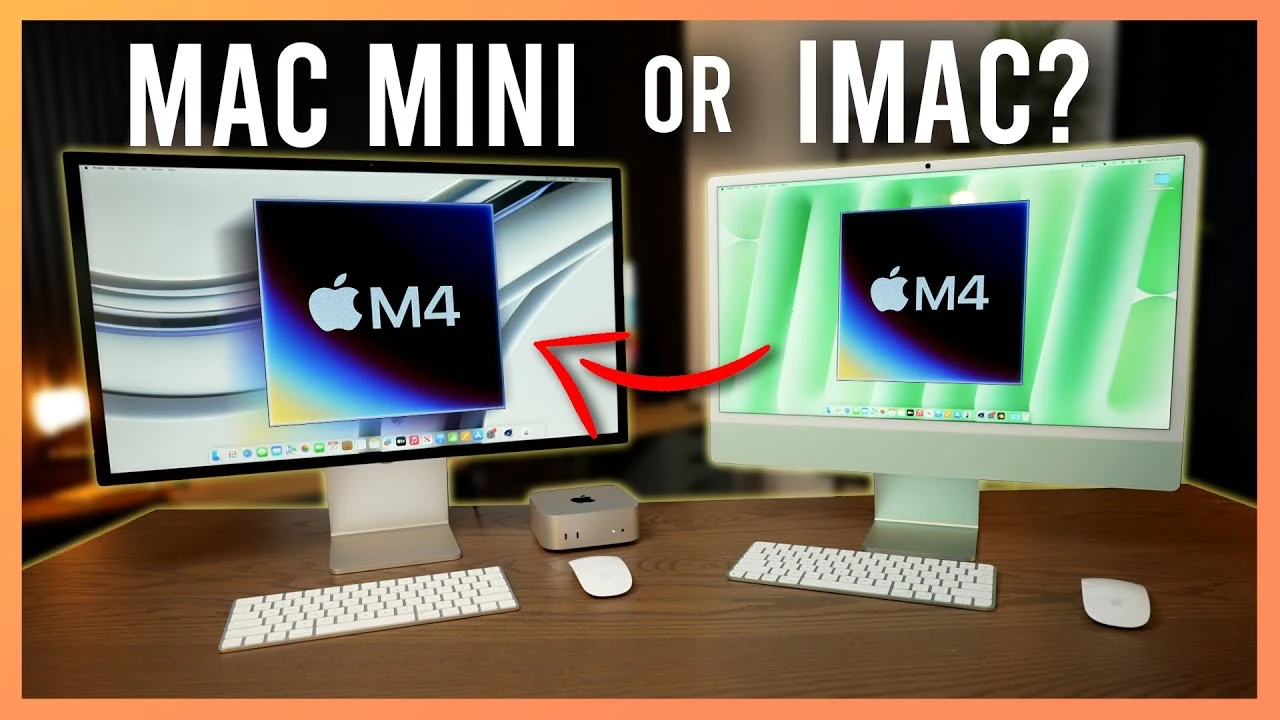The M4 iMac and M4 Mac Mini represent two distinct approaches to desktop computing, each catering to specific user preferences and needs. While the iMac combines an all-in-one design with integrated features for a seamless experience, the Mac Mini prioritizes performance, modularity, and affordability. Choosing between these two devices ultimately depends on what matters most to you, whether it’s performance, aesthetics, or customization.
Performance: Power vs. Balance
When it comes to raw performance, the M4 Mac Mini takes the lead. It houses the full version of Apple’s M4 chip, delivering approximately 35% faster performance in CPU-intensive tasks compared to the iMac, which uses a slightly scaled-down version of the same processor. Benchmarks like Cinebench highlight the Mac Mini’s edge in demanding workloads such as:
GPU performance differences between the two devices are less pronounced. Both the iMac and Mac Mini handle graphics-intensive tasks capably, but neither is specifically designed for high-end gaming or professional 3D rendering. The Mac Mini excels in thermal management, maintaining cooler temperatures during prolonged use, while the iMac’s all-in-one design can lead to slightly higher thermal constraints under heavy loads.
Design: Integrated Elegance vs. Modular Flexibility
The iMac showcases simplicity and sophistication through its all-in-one design, integrating the display, processor, and peripherals into a single, streamlined unit. With color-matched accessories like the keyboard and mouse, it serves as both a design statement and a functional device. Setting up the iMac is effortless—simply plug in the single power cord, and you’re ready to go. This makes the iMac a favorite for:
- Creative spaces
- Home offices
- Anyone who values a clutter-free workspace
In contrast, the Mac Mini embraces a modular philosophy. While it lacks an integrated display and peripherals, this approach offers the freedom to choose components that suit your specific needs. Whether you prefer a high-resolution monitor, a mechanical keyboard, or a specialized mouse, the Mac Mini adapts to your preferences. However, this flexibility comes with added effort and cost, as you’ll need to assemble a complete setup yourself.
Features: Usability vs. Future-Proofing
The M4 generation brings notable updates to both devices. The iMac now includes:
- USB-C accessories
- A Center Stage camera for dynamic video call tracking
- An optional nanotexture display that reduces glare in bright environments
These enhancements make the iMac a well-rounded choice for everyday tasks and creative work. The Mac Mini, however, focuses on functionality and long-term adaptability. Its standout feature is removable storage, allowing you to upgrade capacity as your needs grow—something the iMac doesn’t offer. This makes the Mac Mini a cost-effective option for users who anticipate expanding their storage over time without paying Apple’s premium upgrade prices.
Cost: Convenience vs. Customization
Price is a significant factor when comparing these two devices. The iMac starts at $1,299 and includes a 24-inch 4.5K Retina display, keyboard, and mouse. This all-in-one package offers excellent value for users who prioritize convenience and aesthetics.
The Mac Mini, with a starting price of $599, is far more affordable but requires additional peripherals. Depending on your choice of monitor, keyboard, and mouse, the total cost can vary widely. A budget-friendly setup might cost around $1,157, while premium configurations can exceed the iMac’s price. This variability makes the Mac Mini a flexible option for users with specific budget constraints or performance needs.
Who Should Choose the iMac?
The M4 iMac is ideal for users who value simplicity, design, and ease of use. Its all-in-one form factor makes it perfect for:
- Families
- Small businesses
- Creative professionals who want a hassle-free computing experience
The included accessories and integrated features make it a plug-and-play solution for most everyday tasks. If you’re looking for a sleek, vibrant centerpiece for your workspace, the iMac delivers.
Who Should Choose the Mac Mini?
The Mac Mini is tailored for tech enthusiasts and professionals who demand higher performance and customization. Its modular design is perfect for users who want to:
- Build a personalized setup with specific peripherals
- Need a compact yet powerful desktop for intensive workloads
- Set up a media server or create a custom workstation
The Mac Mini offers unmatched versatility for these scenarios.
Use Cases: Where Each Device Excels
The iMac shines in environments where design and ease of use are paramount. It’s an excellent choice for:
- Home offices
- Family computers
- Professional settings where a sleek, integrated solution is preferred
Its vibrant display and color-matched accessories make it a standout addition to any workspace.
The Mac Mini, by contrast, thrives in scenarios that demand flexibility and performance. It’s a powerful and adaptable choice for:
- Developers
- Content creators
- Those building custom workstations
The Mac Mini’s modularity and upgradeability make it an ideal fit for these use cases.
Summary
Deciding between the M4 iMac and M4 Mac Mini ultimately comes down to your priorities. If you value design, simplicity, and an all-in-one solution, the iMac is the clear winner. However, if performance, customization, and cost-effectiveness are your main concerns, the Mac Mini offers greater flexibility and power.
By carefully assessing your specific needs, budget, and preferences, you can confidently choose the desktop that aligns best with your goals. Whether you opt for the iMac’s integrated elegance or the Mac Mini’s modular versatility, both devices offer exceptional performance and value within the Apple ecosystem.
Source & Image Credit: Luke Miani
Filed Under: Apple, Guides, Top News
Latest TechMehow Deals
Disclosure: Some of our articles include affiliate links. If you buy something through one of these links, TechMehow may earn an affiliate commission. Learn about our Disclosure Policy.
